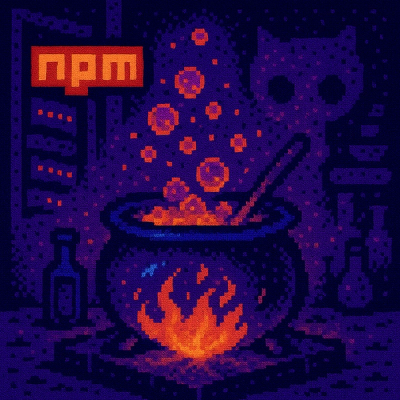
Research
/Security News
9 Malicious NuGet Packages Deliver Time-Delayed Destructive Payloads
Socket researchers discovered nine malicious NuGet packages that use time-delayed payloads to crash applications and corrupt industrial control systems.
react-media-query-hoc
Advanced tools
A dead simple React Higher Order Component (HOC) that uses context for matching media queries
A dead simple React Higher Order Component (HOC) that uses context for matching media queries.
MediaQuery components all over your code baseMediaQueryProvider that listens to media events you wish to configure)We generally recommend using vanilla CSS media queries to build responsive websites, this is simpler, provides a smoother UX, also it mitigates having to guess the screen width during server side rendering. Use this library if you need to dramatically alter the page layout between media types (some examples include: an experiment needs to be run on a specific screen width or an advertisement needs to be on specific screen width).
Via NPM:
npm install react-media-query-hoc --save
Via Yarn:
yarn add react-media-query-hoc
This library is designed so that you have 1 MediaQueryProvider parent and 1-many child components wrapped with withMedia HOC
MediaQueryProviderThis component will listen to media events you want to configure, it should be used once as a parent component.
Usage:
import { MediaQueryProvider } from 'react-media-query-hoc';
const App = (props) => {
return (
<MediaQueryProvider>
<TheRestOfMyApp />
</MediaQueryProvider>
);
};
export default App;
By providing no queries prop to the MediaQueryProvider component, it will default to these media queries
But you can provide different media queries for your use case using the queries prop, eg:
const App = (props) => {
const customQueries = {
verySmall: 'screen and (max-width: 300px)',
someOtherMediaQuery: 'screen and (min-width: 301px)',
};
return (
<MediaQueryProvider queries={customQueries}>
<TheRestOfMyApp />
</MediaQueryProvider>
);
};
withMediaThis is a HOC to provide media match props to your component.
Usage:
import { withMedia } from 'react-media-query-hoc';
const MyComponent = ({ media, ...props}) => {
if (media.tablet || media.mobile) {
return (
<div>
Mobile and Tablet View
</div>
)
}
return (
<div>
Other View
</div>
);
};
export const BaseMyComponent = MyComponent;
export default withMedia(MyComponent);
Components wrapped by withMedia() won't work with React's usual ref mechanism, because the ref supplied will be for withMedia rather than the wrapped component. Therefore a prop, wrappedRef provides the same function. Note: this means the wrapped component can not be a stateless function.
MediaContextThis is the React Context exported and ready to be used with React useContext hook. It has a default value of {}, present when the component that consumes the context is not wrapped with MediaQueryProvider.
import { MediaContext } from 'react-media-query-hoc';
import { useContext } from 'react';
const MyComponent = (props) => {
const media = useContext(MediaContext);
if(media.tablet || media.mobile) {
return (
<div>
Mobile and Tablet View
</div>
)
}
return (
<div>
Other View
</div>
);
};
export default MyComponent;
// default value
ReactDOM.render(<MyComponent />); // Renders 'Other View';
You can pass in media features from your server, all supported values can be found here.
Usage (matches mobile screen during SSR):
const App = (props) => {
const values = {
width: 300,
type: 'screen',
};
return (
<MediaQueryProvider values={values}>
<TheRestOfMyApp />
</MediaQueryProvider>
);
};
It's very important to realise a server client mismatch is dangerous when using hydrate in React 16, ReactDOM.hydrate
can cause very strange html on the client if there is a mismatch.
To mitigate this we use the two-pass rendering technique mentioned in the React docs.
We render on the client in the first pass using values with css-mediaquery used on the server, then we use the browsers native window.matchMedia
to get it's actual dimensions and render again if it causes different query results. This means there should be no React
server/client mismatch warning in your console and you can safely use hydrate. As a result of above, if you are server side rendering and using ReactDOM.hydrate you must supply MediaQueryProvider a values prop.
The oldest browser we support is IE11,
if you want to support even older browsers please make sure you are using a polyfill for Map such as babel-polyfill.
Because the media queries and context are abstracted out you can easily test components with or without the withMedia HOC, just ensure you export your component base without the HOC as well, eg:
export const BaseMyComponent = MyComponent;
export default withMedia(MyComponent);
Then in your React tests you can import like:
import { BaseMyComponent } from 'location_of_my_component';
And unit test the component without having to worry about context
Big thanks to the maintainers of these repos
Both libraries are a bit similar, but my original use case required the extra advantages listed in Why use this?
FAQs
A dead simple React Higher Order Component (HOC) that uses context for matching media queries
We found that react-media-query-hoc demonstrated a not healthy version release cadence and project activity because the last version was released a year ago. It has 2 open source maintainers collaborating on the project.
Did you know?

Socket for GitHub automatically highlights issues in each pull request and monitors the health of all your open source dependencies. Discover the contents of your packages and block harmful activity before you install or update your dependencies.

Research
/Security News
Socket researchers discovered nine malicious NuGet packages that use time-delayed payloads to crash applications and corrupt industrial control systems.

Security News
Socket CTO Ahmad Nassri discusses why supply chain attacks now target developer machines and what AI means for the future of enterprise security.

Security News
Learn the essential steps every developer should take to stay secure on npm and reduce exposure to supply chain attacks.